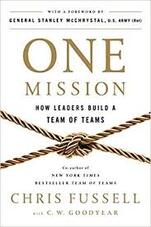 I was debating the pros and cons of various organizational structures with a colleague of mine who's a former Navy SEAL, and he was kind enough to gift me the book One Mission: How Leaders Build a Team of Teams written by Chris Fussell, with whom he worked on the Teams before. Before reading this book, I always thought of "bureaucracy" as a bad word, but now I see why it exists and what important functions it serves. I also got a really good sense as to how to build a hybrid organization that aims to balance between periods of decentralization/agility/bottom-up with periods of stability/centralization/top-down. I also really enjoyed hearing about how to implement O&I (Operations & Intelligence) Forums to get key stakeholders on the same page quickly using technology, and how to match the operating rhythm of a group with that of its environment/market. I aim to put in practice a lot of the major lessons from this book. My major notes and takeaways are below. Foreword
Strength and stability of hierarchy plus speed and agility of decentralized network Intro Trust Common purpose Shared consciousness/common understanding Empowered execution. Decentralized. High accountability. Hybrid organizational model One mission. Unifying empowering narrative. 1 one mission Intimacy within organization Clans and objects as prizes after victories Did you earn your trident today? Squeezing hand of helicopter pilot = team intimacy. Trust. 2 the hybrid model Bureaucracy advantages plus network advantages Bureaucracy removes subjectivity and personality and allows centralized control at scale Manager as info hub between individuals who produce As you go higher up, you feel more distant from firsthand direct contribution and situational knowledge Complicated to complex systems Networks. Decentralized. Relationships as dotted lines and not hierarchical. Clustering. Driven by narrative. Best for crisis and adaptation but bad for long term planning. Hybrid model. Dotted lines for informal cross-silo relationships. 3 an aligning narrative Octopus Brains distributed throughout the body and can make decisions independently but also coordinated when needed The starfish and the spider Powerful narrative to align teams Strategic alignment. Balanced scorecard system. Management by objectives (Drucker). Credibility = proven competence + relationships + integrity Horizontal alignment Case study intuit Quicken beat Microsoft money Recurring forums to share knowledge 4 interconnection Influencers, hubs, connectors. Focus on them first. No fly zone: new hires get 60-90 days to study actual web of relationships and how stuff gets done before can fly independently and work on big things Boundary spanners: connect people across silos Collocation. Virtual decision forums. O&I Forum. Massive videoconferencing forum which actually solves problem. Goal is collective learning not grading. Open exchange across ranks. Thousands dialing in for 90 minutes daily. O&I Controller Not knowing was acceptable. Not thinking wasn’t. Agenda carefully designed and distributed ahead of time Hyperlinks to detailed docs and contact info Live chat rooms with sub-threads between varied groups Signing off and realigning by senior team. Reminder about what matters. Every 24 hours Ground rules for attendance, punctuality, device free Sample agenda items Full time controller interviewed and hired to run the forum daily 5 operating room Operating rhythm Empowered engagement. Decentralized action. Balance between stability and fluidity Balance and ratios Consider speed and competition Fighting al qaeda required 24 hour operating rhythm Cycle between decentralized operation and resync with rest of org Tactical moves faster than operational than strategic 90 min of O&I followed by 22.5 hours of execution Can do this weekly if environment is slower From x1 to x2 Delays due to dating of info as it moves up the chain X1 is when new info tactically identified x2 is when it’s acted upon X2-x1=action gap/delay 6 decision space Outline what actions team has authority for Decision space is range of things a team can do during period of empowered execution and discussing during shared consciousness Key things from team of teams Create aligning narrative Building Shared communications forums Driving shared consciousness at an appropriate operating rhythm Hesitance: reluctance to take action Deviance: stepping beyond allowed area Positive deviants 7 liaisons Better info sharing Formalized role as opposed to boundary spanners Conclusion References Prior book Team of Teams The starfish and the spider Give and take
0 Comments
Your comment will be posted after it is approved.
Leave a Reply. |
Archives
June 2024
Categories
All
Subscribe |
 RSS Feed
RSS Feed
